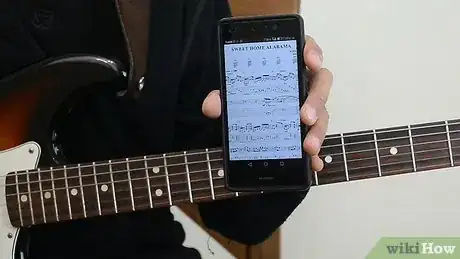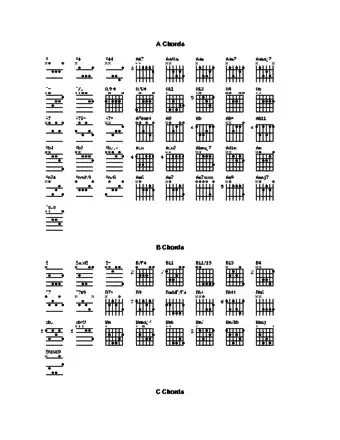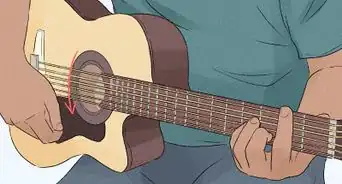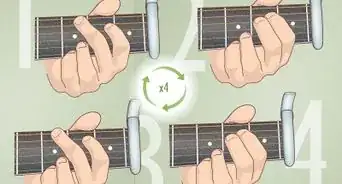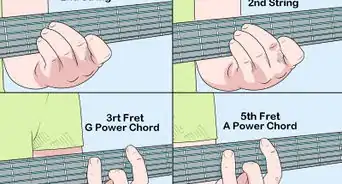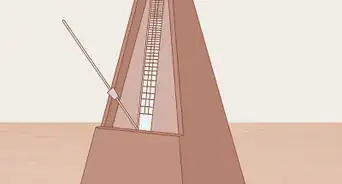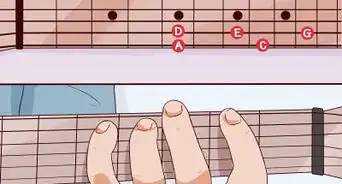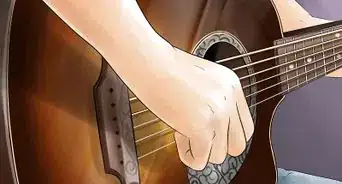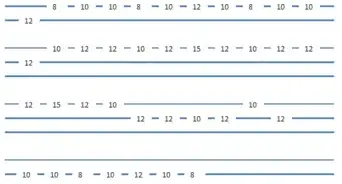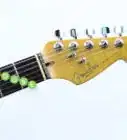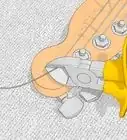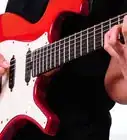This article was co-authored by Nicolas Adams. Nicolas Adams is a 5th generation musician of Serbian Gypsy descent and the lead guitarist of the band Gypsy Tribe. Based in the San Francisco Bay Area, Nicolas specializes in Rumba Flamenco and Gypsy jazz and playing the guitar, Bouzouki, Balalaika, and piano.
There are 10 references cited in this article, which can be found at the bottom of the page.
wikiHow marks an article as reader-approved once it receives enough positive feedback. This article has 30 testimonials from our readers, earning it our reader-approved status.
This article has been viewed 5,852,301 times.
You can use a guitar to play anything from death metal to classical and everything in between. Learning to play guitar is more approachable than learning to play many other instruments, once you master a few basics. You, too, can learn how to get started teaching yourself to play.
Steps
Learning the Basics
-
1Identify the parts of the guitar. Whether you're playing an electric or an acoustic guitar, the instrument is essentially wood and metal. Copper-wound strings vibrate to create sound. The wooden body resonates that sound to create the warm tones we associate with a guitar.[1]
- The strings run between the headstock of the guitar, where they are affixed to tuning pegs that can be rotated to tighten and slacken them, and the bridge, where they're fixed to the guitar's body. On an acoustic guitar, the strings are fixed to the bridge with removable pegs, and on an electric guitar the strings are generally strung through an eyelet.
- The neck of the guitar is the long wooden piece of wood, flat on one side (this is called the fretboard) and curved on the other. The fretboard is inlaid with metal frets that demarcate the different notes.
- An acoustic guitar will have a sound hole in the body where the sound will resonate, while an electric guitar will have as many as three magnetic pickups which will channel the sound through an amplifier.
-
2Hold the guitar correctly. Before you start wailing like Hendrix, make sure you're holding your guitar correctly. If you're right handed, you'll play the guitar by strumming about halfway between the sound hole and the bridge with your right hand and fretting the strings on the neck with your left hand.[2]
- To play your guitar, sit up in a straight-backed chair or stool. When you orient the guitar to your body, the smallest string should be pointed toward the ground and the thickest string should be pointed up at the ceiling. Hold the back of the guitar so it touches your stomach and chest and rests on the leg of your strumming/picking hand.
- The guitar should be held mostly with your leg and by cradling it in your body. Your left hand is used to stabilize the neck and fret the strings. Hold the neck in the V created by your thumb and forefinger. You should be able to smoothly move your left hand up and down the neck without having to hold it up.
- Even if you hold the guitar correctly, you may experience some discomfort while getting used to playing. Do not become discouraged if your shoulder hurts in addition to your neck, arms and hands. You will eventually get used to it.
Advertisement -
3Tune the guitar. It's no fun to play a guitar that's not in tune and can lead to some bad habits when you're first starting out. Tuning regularly will also familiarize you with which string and fret combinations correspond with which notes.[3]
- Learn the name of each string. From the lowest to highest pitch (thickest to thinnest strings) the strings are named E, A, D, G, B, and E (after the note played when the string is plucked with no fingers touching it). Use a mnemonic to remember this order, such as "Eddie Ate Dynamite, Good Bye Eddie!"
- Electric tuners are easy to use and very accurate. Hold it to the guitar and pluck the high E. The tuner will tell you if the guitar is "sharp" (too high) or "flat" (too low). Pick each note and tighten the string to make it go higher, or give it some slack to lower it. Make sure the room is quiet when using a tuner because the microphone on the tuner can pick up other sounds.
- If you cannot afford a tuner, you can also tune your guitar without one by matching each note to the corresponding note on the piano.
-
4Practice fretting the strings. The frets are the metal strips that run perpendicular to the strings that mark each note. To play a note, press your finger down between the metal strips, not on them. To say that you're playing the third fret means that you place your finger on the string in the gap between the second and third fret. If you hear buzzing, move your finger away from the lowest fret and closer to the higher fret. Hold the string down firmly so that it only vibrates between your finger and your strumming hand, with the tip of your finger doing the pressing.
- Every time you move from one fret to another, the resulting pitch will be half a step higher as you move toward the body and a half step lower as you move toward the headstock. Practice moving up and down the fretboard, pressing the frets and getting a feel for the pressure you need to use to play a note.
-
5Hold the pick. A pick, or plectrum, is a small tear-shaped piece of plastic used for picking out individual notes and strumming the guitar. They're cheap and available at any music retailer. While it's not essential to learn to play guitar with a pick, it's most generally the way to start.
- Make a fist with your picking hand and your thumb flat on top of your curled fingers. Hold the pick by grasping it perpendicular to your fist between your thumb and index finger, with no more than a few centimeters of the smaller end sticking out of your hand.[4]
Playing Chords
-
1Learn first position chords. A chord is a harmonic group of at least three notes. For beginning guitar, there are two basic chord types: first position chords, and barre chords. First position chords can be played with a combination of open strings and pressed strings in the first three frets of the guitar.
- Commonly major chords are C Major, A Major, G Major, E Major, D Major.
- When you've got the shapes down, practice switching between them as quickly as you can. Write out more or less random arrangements of the chords you want to play and switch between them, strumming once.
- Make sure you play the appropriate notes. In A Major, for example, the low E string is not strummed. They'll be marked on the tablature with an "X". Develop good habits now for success in the long run.
EXPERT TIPNicolas Adams is a 5th generation musician of Serbian Gypsy descent and the lead guitarist of the band Gypsy Tribe. Based in the San Francisco Bay Area, Nicolas specializes in Rumba Flamenco and Gypsy jazz and playing the guitar, Bouzouki, Balalaika, and piano.Professional Guitarist
 Nicolas Adams
Nicolas Adams
Professional GuitaristYou can play an entire song by simply switching between minor chords. For example, try learning E-minor and A-minor first because they're easy to play. You can go from A-minor to E-minor into an F and then back to A-minor, creating a chord progression.
-
2Learn finger placement for the chords. The finger placement is as follows (first major, then minor):[5]
- C-chord: Place your ring finger on the third fret of the fifth string. Place your middle finger on the second fret of the fourth string, and your index finger on the first fret of the second string. Strum all but the sixth string. Then, go back and play each string individually, while still playing the chord. Make sure each string rings out clearly.
- A major: Take your index, middle, and ring finger, and place them on the second frets of the second, third and fourth strings on the guitar. It is simply one line down these three strings. Play every string but the top one.
- G chord: Place your middle finger on the third fret of the sixth string. Place your index finger on the second fret of the fifth string, and your ring finger on the third fret of the first string. Make sure each string rings out clearly.
- E Major: This is one of the easiest chords there is. Place your middle and ring fingers on the second frets of the fourth and fifth strings. Your index finger should go on the first fret of the third string.
- D Major: Place your index finger on the second fret of the third string. Place your middle finger on the second fret of the first string. Place your ring finger on the third fret of the second string. Only play the bottom four strings.
- E minor: This is exactly like E major, except you don't use your index finger. Put your middle and ring fingers on the second frets of the second and third thickest strings.
- A minor: Place your middle and ring fingers on the second frets of the third and fourth thickest strings, and your index on the first fret of the second thinnest. This is the exact same shape as E major, just moved down one string. Again, ignore the top string.
- D minor: Again, very similar to D Major. Place your middle finger on the second fret of the third thinnest string. Place your index finger on the first fret of the thinnest, and your ring finger on the third fret of the second thinnest. Play only the bottom four strings.
-
3Practice getting a clean sound from every string in the chord. After you had placed all your fingers on the fretboard, play through each of the strings of the chords. Make sure that the strings that are supposed to ring are not muffled or muted.
- If the notes are not ringing out properly, chances are that you are not pressing hard enough or parts of your fingers are touching that string which prevents it from sounding out clearly. Are any unused fingers touching strings?
- Keep your fretting fingers curled above the fret board when they're touching the strings as if you had your fingers resting over an imaginary glass ball, or a marble in the knuckle of each finger.[6] This leaves space for the open strings to ring out unmuted.
-
4Strum with loose, relaxed motion.[7] Strumming consists of downstrokes and upstrokes in various combinations, striking all the notes of the chord evenly and rhythmically. Use your wrist to practice smooth up and down motions. Keep your elbow in tight towards the guitar and sweep the pick down all the strings. Your elbow should not move very much, as you strum mostly from the wrist.
-
5Learn barre chords. Barre chords, or movable chords, are extremely useful for starting to play songs. In a barre chord (sometimes shortened to "bar chord"), the index finger of your fretting hand "bars" all the notes at a single fret. To play an F, which is the barre chord in first position, you bar all the notes on the first fret with your index finger and play what is essentially the shape of the E chord moved one step up the neck, with your middle, ring, and pinkie.[8]
- Using the same claw-like finger positioning on the second fret, you can play an F# chord. Move to the third fret, and it becomes a G chord. It's a difficult finger positioning to learn, but you can start playing the chords to any rock or pop song relatively quickly when you learn to strum and play barre chords. The Ramones, for example, used nothing but barre chords to great effect.
Sticking With It
-
1Manage the finger pain. There'll be a point at which things will seem bleak: you can't quite get to each chord as fast as you want, your fingers are killing you, and it seems easier to put the thing back in its case. The reason most guitar players stop playing a few weeks in is that it hurts. After a couple of months and years of playing, callouses will build up on the fingers of your fretting hand that will greatly reduce the pain of pushing down the strings for long periods of time. Everyone who learns to play the guitar has to deal with sore fingers at the beginning. Learn to love the pain and associate it with everything that you love about music and the guitar.
- Ice your fingers after playing or soak them in some apple cider vinegar to alleviate some of the pain.
- Dipping your fingers in rubbing alcohol after playing can speed up callus build up. Just don't do it before you play.[9]
-
2Learn to play some songs. It's a whole lot more fun to play when you're playing a song that you can recognize and not just a set of chords or notes. Even better, 90% of music is made up of only 3-4 chords. Follow the link in the bolded text to find ten songs you can play with only four chords.
- Start off slow and speed up gradually as you get used to the rhythm. It can be frustrating how mechanical you will sound at first, but the more comfortable you get switching between the chords, the closer you'll be to rocking out on stage.
- As you master easier songs, move on to more complex pieces. "Sweet Home Alabama" by Lynyrd Skynyrd is basically a repetition of D, C, and G in that order, but it sounds much more complex on the record because of the lead guitar licks.
-
3Learn how to read guitar tabs. Guitarists have their own system of music notation called guitar tablature, or guitar tabs for short. The basic idea is to look at each line in the "staff" of the tab in the same way you look at your guitar. Each line corresponds to a string, and each number tells you which fret to hold down when plucking that string. For example, to play this tab-notated lick from the Lynyrd Skynyrd song "Sweet Home Alabama," you would play two notes on the open D string, the B string at the third fret, the G string at the second fret, etc.[10]
- E|-------------------------------------------------||
- B|-------3---------3----------3--------------------||
- G|---------2---------0--------0---------------2p0--||
- D|-0-0------------------------0--0----0h2p0--------||
- A|------------3-3-------------2---0p2-------0------||
- E|-----------------------3-3--3--------------------||
- Switching between lead-style licks and chords is exciting. You'll feel like you're really making music and not just "learning guitar." Make sure you've got your chord shapes down correctly and that you're not losing the rhythm entirely when you play a quick lick.
-
4Learn from others. The guitar is best learned by watching, listening, and mimicking the techniques of others. You don't have to take formal lessons to learn guitar, but having friends to play with and share tricks and suggestions with can be a great resource.
- YouTube tutorials can be extremely helpful for beginners and for advanced players alike. Watching Stevie Ray Vaughn rip through a solo or seeing how Jack Johnson fingers your favorite song can be a great learning experience.
- If you'd like to play classical or jazz guitar, or even if you'd like to learn to read sheet music, formal lessons are a good idea. Teaching yourself is a great way of developing your own style, but there is only so much you can learn without a knowledgeable mentor.
Beginner Guitar Help
Expert Q&A
-
QuestionWhat are the 4 basic guitar chords?
 Nicolas AdamsNicolas Adams is a 5th generation musician of Serbian Gypsy descent and the lead guitarist of the band Gypsy Tribe. Based in the San Francisco Bay Area, Nicolas specializes in Rumba Flamenco and Gypsy jazz and playing the guitar, Bouzouki, Balalaika, and piano.
Nicolas AdamsNicolas Adams is a 5th generation musician of Serbian Gypsy descent and the lead guitarist of the band Gypsy Tribe. Based in the San Francisco Bay Area, Nicolas specializes in Rumba Flamenco and Gypsy jazz and playing the guitar, Bouzouki, Balalaika, and piano.
Professional Guitarist The A minor or A major, which are literally one finger difference, and then E minor or E major, are always the best chords to start with. Then eventually, from there, you can add a D major or D minor, depending on the scale.
The A minor or A major, which are literally one finger difference, and then E minor or E major, are always the best chords to start with. Then eventually, from there, you can add a D major or D minor, depending on the scale. -
QuestionHow can I teach myself to play guitar?
 Nicolas AdamsNicolas Adams is a 5th generation musician of Serbian Gypsy descent and the lead guitarist of the band Gypsy Tribe. Based in the San Francisco Bay Area, Nicolas specializes in Rumba Flamenco and Gypsy jazz and playing the guitar, Bouzouki, Balalaika, and piano.
Nicolas AdamsNicolas Adams is a 5th generation musician of Serbian Gypsy descent and the lead guitarist of the band Gypsy Tribe. Based in the San Francisco Bay Area, Nicolas specializes in Rumba Flamenco and Gypsy jazz and playing the guitar, Bouzouki, Balalaika, and piano.
Professional Guitarist It's really important to start correctly. Don't just know a chord, but learn what the chord is, lwhat that chord can do, and where you go from that chord. That's the best way to start. Once you understand what the possibilities are, from each chord, from each note, from each sound, and how they blend and move together, it will be a lot easier.
It's really important to start correctly. Don't just know a chord, but learn what the chord is, lwhat that chord can do, and where you go from that chord. That's the best way to start. Once you understand what the possibilities are, from each chord, from each note, from each sound, and how they blend and move together, it will be a lot easier. -
QuestionIs 16 too late to start?
 Community AnswerIt's never too late to start playing. Go for it!
Community AnswerIt's never too late to start playing. Go for it!
Warnings
- Be careful not to practice too much at first. An hour a day would be enough. Don't hurt your fingers.⧼thumbs_response⧽
- Depending on written or video tutorials without the help of lessons from an experienced teacher could lead to bad habits that are difficult to reverse. While you may learn just as effectively without formal lessons, they may be useful to correct any personal playing problems.⧼thumbs_response⧽
Things You'll Need
- A guitar that you feel will be suitable
- A pick (optional)
- A tuner (recommended for beginners)
References
- ↑ http://www.alhambrasl.com/en/blog/62/parts-of-a-guitar:-get-to-know-your-instrument.html
- ↑ https://www.guitarlessons.com/guitar-lessons/beginner-guitar-quick-start-series/how-to-hold-the-guitar
- ↑ https://www.chordbuddy.com/guitar-learning-system-for-everyone/how-to-play-the-guitar-for-beginners/guitar-tuning/
- ↑ https://takelessons.com/live/guitar/how-to-hold-a-guitar-pick
- ↑ http://fingerstofrets.com/#Dmv1
- ↑ https://www.thoughtco.com/fat-fingers-guitar-1711994
- ↑ http://www.guitarlessonsforbeginners.com/strum-the-guitar.htm
- ↑ https://www.libertyparkmusic.com/barre-chords-made-easy/
- ↑ https://www.theguitarlesson.com/guitar-lesson-blog/beginner-guitar-lessons/build-calluses-guitar/
About This Article
To play the guitar, first get in position. Rest the guitar on your right leg. Then, place your right hand over the strings with your elbow out to the side. Place your left thumb against the back of the fret board, and place your fingers lightly on the strings. Keep your thumb placed around the middle height of the fretboard, and try to keep your wrist relaxed. Next, learn the strings. The top string is number 6, followed by 5, 4, 3, 2, and 1. They also have letter names: E, A, D, G, B, and E. You can remember this with the mnemonic, Elephants And Donkeys Grow Big Ears. Then, tune the guitar using the knobs on the guitar's neck. Now, try to learn a basic chord like a C-chord. Place the ring finger of your left hand around the third fret of the fifth string. Then, place your middle finger on the second fret of the fourth string. Finish by placing your index finger on the first fret of the second string. Strum the guitar from the fifth string down to play the C Chord, making contact with each string as you strum down. Practice strumming up and down a few times, keeping your wrist soft as you strum.



